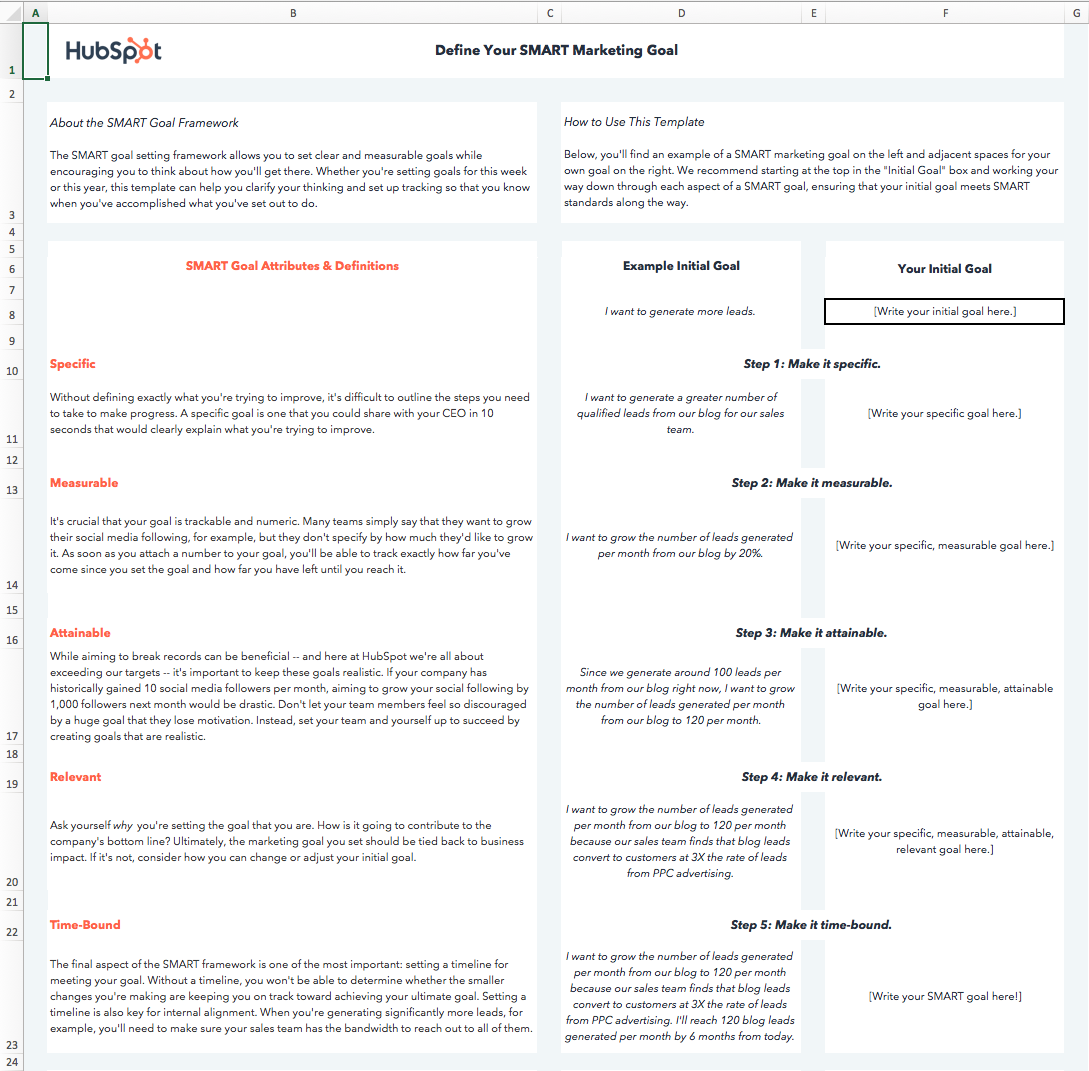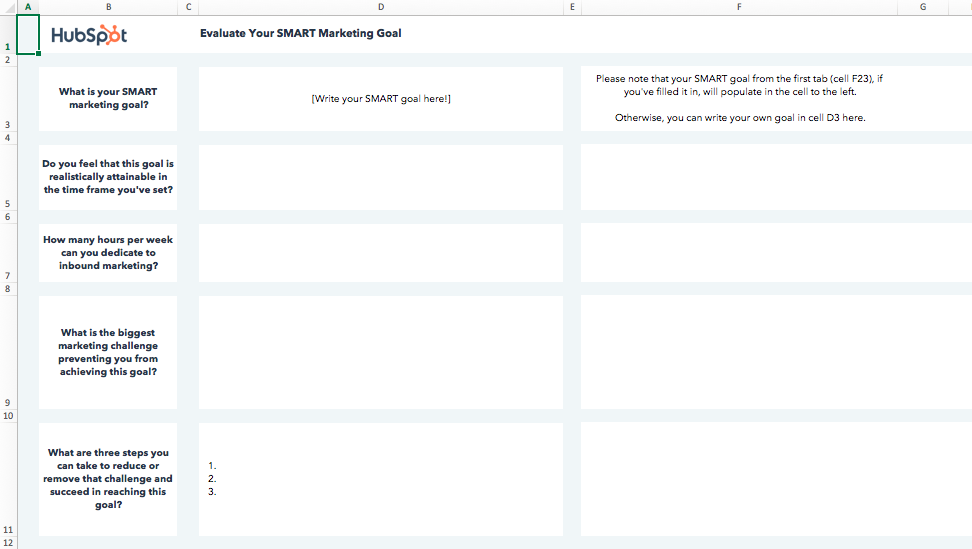There's almost nothing more gratifying than the feeling you get when you accomplish a goal.
Whether you're pressing "Publish" on a blog post or collecting initial analytics on a campaign months in the making, it's undeniably satisfying to know you've successfully finished a task.
When you're not chasing a clear goal, though, work can feel like a never-ending grind. Without goals, you're setting yourself up to feel like the work you're doing isn't enough -- or, worse, you position yourself to do work that doesn't actually impact your company's bottom line.
Making your goals SMART is an effective method for clarifying your motivations, setting a clear direction for you and your team members, and ensuring you're able to celebrate the wins when they come along.
To help you write SMART goals, we've created a free template with all the tools needed to get you started. But first -- what exactly is a SMART goal, and how does it differ from a regular goal?
What is a SMART goal?
The letters of SMART stand for:
- Specific
- Measurable
- Attainable
- Relevant
- Time-Bound
The SMART acronym is a framework that will enable you to write goals that drive greater impact. Write goals with each of these aspects in mind, and you'll be able to quantify how far you've come and how far you have left to go against your goal.
When you reach the milestone you articulated in your SMART goal, you'll be able to celebrate knowing that you achieved something tangible and impactful.
To make the process of setting a SMART goal simple, we've created a free, downloadable SMART goal setting template. I'll walk through the template as we discuss each aspect of a SMART goal, below.

I'd suggest downloading the template yourself to follow along throughout the rest of this blog post. Next, let's dive into the importance of each aspect of the SMART acronym.
What does each aspect of the SMART acronym actually mean?
While we run through the definition behind each aspect of the SMART framework, we'll apply the framework to a real-world example as we go. You can download the template to follow along (input your starting goal in cell F8) or simply write your starting goal on a piece of paper.
Let's start with a basic, non-SMART goal as our example -- "I want to get more fit."
1. Specific
Goal setting is often associated with striving toward our highest aspirations -- and actually reaching those aspirations can seem daunting. Specificity helps us determine the path between where we are, and where we want to be.
"Getting more fit" is ambiguous. There are innumerable ways to get more fit, and everyone has their own definition of fitness -- for instance, are you looking to lose weight? Perform more push-ups? Cut a minute off your mile time?
When a goal isn't specific, there is no way to tell whether the actions you're taking are going to help you achieve that goal. If your specific fitness goal is actually to increase the number of push-ups you can do at one time, following a running plan isn't going to be very helpful in getting you to your true goal.
A specific goal is one that makes your next steps clear -- or, at the very least, narrows down the potential next steps you might take.
To specify what we mean by "I want to get more fit,'' I'll alter our example goal to read, "I want to be able to do more push-ups."
If you're following along in the template, make your goal more specific and type it into the cell under Step 1.

2. Measurable
When a goal is measurable, you can easily track your progress. Typically, this means that a number will be attached to your goal.
A numerical goal is valuable for many reasons. In addition to giving you something to strive toward, you'll be able to celebrate a victory when you reach the final benchmark.
If you say that you just want to do more push-ups", for instance, does that mean that you want to be able to complete just one more push-up per session, or that you want to double the number of push-ups you can do overall? One goal will take a lot more time and dedication to achieve than the other.
Let's say I can do ten push-ups in a row right now. To allow us to measure our progress against our final goal and know when we've reached a milestone, we'll edit our push-ups goal to read, "I want to be able to do 25 push-ups in a row."
3. Attainable
I've set some pretty lofty goals before -- and if you're reading this, you're probably a self-motivated person, too.
Big aspirations are admirable, but it's important to balance long-term goals with more achievable, short-term goals.
Setting attainable goals is all about looking at what you've done so far and adjusting your goals to be realistic relative to those benchmarks.
To consider the point in more concrete terms, think about business growth rates -- if your company has been selling 2% more product each month for the past 12 months, aiming to sell 15% more product next month would be an unrealistic goal. Keep in mind that 2% growth is the status quo -- so a good stretch goal might be selling 3 or 4% more product next month. Selling 4% more product would still be doubling your month-over-month growth.
Attainable goals are useful because they help you maintain momentum. It can be hugely discouraging to miss huge targets, whereas consistently making small gains will encourage you to continue delivering wins.
Each month, you'll be aiming for the familiar satisfaction of hitting your target rather than dreading another seemingly major miss.
For instance, to make our example goal a bit more attainable, I'll move the target from 25 push-ups to 20 push-ups. There's still a significant amount of work required to get to where I want to be, but I'll be able to celebrate a huge achievement -- doubling the amount of push-ups I can do -- and use that momentum and celebration to drive me to set a goal of doing 25 push-ups soon after I achieve my goal of 20.
Consider what you've done in the past in relation to the goal you're in the process of setting, and adjust it accordingly.
4. Relevant
Relevant goals are ones that will help you move in the direction you truly desire. You can allocate your time to an infinite amount of activities, but which activities will actually push you closest to your ultimate goals?
It's a common trap to feel like we're being productive when we're busy, even if our action isn't creating a meaningful impact.
In the beginning, our example goal was to "get more fit." To make sure our goal is relevant, we need to ask ourselves whether following through on this goal will really help us get to where we want to be.
In the case of our push-up goal, the answer is yes. Push-ups engage several muscle groups, including your back, arms, shoulders, and core, and doing a significant number consecutively can definitely elevate your heart rate. Therefore, executing on this goal will improve my muscular strength and perhaps even my cardiovascular strength, both of which are key elements to overall fitness.
Ask yourself whether the goal you've set is going to create real impact on your overarching targets, and adapt it or identify a way to track impact if the answer is currently no.
I'll adjust our example goal to include its overarching purpose: "I want to be able to do 20 push-ups in a row to improve my overall muscular fitness."
5. Time-bound
The final letter of the SMART acronym stands for time-bound. You should always aim to accomplish your goal within a specific time period. Adding in a time frame will not only motivate you to take steps every day toward your goal, but also allow you to track how much progress you've made against your goal versus the time that's passed.
If I’m aiming to increase the number of push-ups I can do by ten in two months, I'm able to set a midpoint milestone of adding five push-ups in the first month. If a month passes and I've only increased the number by three, I'll know I need to ramp up my efforts, re-evaluate my strategy for increasing my push-up strength, or adjust the time frame I initially chose.
Additionally, a time frame can help you chart your progress. I'll make our example goal time-bound by saying, "I want to be able to do 20 consecutive push-ups two months from today to improve my overall muscular fitness." Now, I have a goal that clarifies the path to where I want to be.
In the final tab of the SMART goals template, you'll be able to document the roadblocks to achieving your goal that you anticipate, and make an action plan for overcoming those roadblocks to set you off on the right foot.

Before I made my goal SMART, it would've been easy for me to make excuses. It wasn't clear how I'd measure whether I'd gotten fitter, or when I was going to check-in with myself to see whether I had.
With my new SMART goal, I have a clear target to aim for and metric for success. I can quickly evaluate whether I'm on pace with achieving my goal or behind, and I can celebrate the achievement when it does come because it's a realistic metric that's relevant to my ultimate goal.
No comments:
Post a Comment